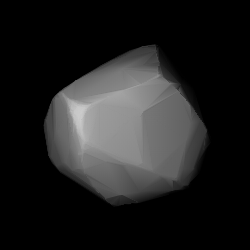Astronomy:180 Garumna
 3D convex shape model of 180 Garumna | |
| Discovery | |
|---|---|
| Discovered by | J. Perrotin |
| Discovery date | 29 January 1878 |
| Designations | |
| (180) Garumna | |
| Pronunciation | /ɡəˈrʌmnə/[1] |
| Minor planet category | Main belt |
| Orbital characteristics[2] | |
| Epoch 31 July 2016 (JD 2457600.5) | |
| Uncertainty parameter 0 | |
| Observation arc | 96.73 yr (35331 d) |
| |{{{apsis}}}|helion}} | 3.1722 astronomical unit|AU (474.55 Gm) |
| |{{{apsis}}}|helion}} | 2.2739 AU (340.17 Gm) |
| 2.7231 AU (407.37 Gm) | |
| Eccentricity | 0.16494 |
| Orbital period | 4.49 yr (1641.3 d) |
| Mean anomaly | 301.92° |
| Mean motion | 0° 13m 9.624s / day |
| Inclination | 0.86595° |
| Longitude of ascending node | 312.18° |
| 175.87° | |
| Earth MOID | 1.28761 AU (192.624 Gm) |
| Jupiter MOID | 1.89216 AU (283.063 Gm) |
| TJupiter | 3.338 |
| Physical characteristics | |
| Rotation period | 23.866 h (0.9944 d) |
| S[3] | |
| Absolute magnitude (H) | 10.31 |
Garumna (minor planet designation: 180 Garumna) is a main belt asteroid that was discovered by the French astronomer Henri Joseph Perrotin on January 29, 1878.[4] Its name comes from the ancient Latin name for the Garonne River in France. In the Tholen classification system, it is categorized as a stony S-type asteroid, while the Bus asteroid taxonomy system lists it with the Sr sub-type.[3]
The rotation period of this asteroid is very nearly equal to that of the rotation of the Earth. This means that only a small portion of the light curve can be observed from any one location, requiring measurements from multiple sites in order to build a complete curve. In 2012, this mission was accomplished, giving a period of 23.866 ± 0.001 hours with a brightness variation of 0.42 ± 0.02 in magnitude. Allowing for a margin of error and changes in phase angle, this finding agrees with previous measurements made in 2008 and 2011.[5]
References
- ↑ Noah Webster (1884) A Practical Dictionary of the English Language
- ↑ Yeomans, Donald K., "180 Garumna", JPL Small-Body Database Browser (NASA Jet Propulsion Laboratory), https://ssd.jpl.nasa.gov/sbdb.cgi?sstr=180, retrieved 6 May 2016.
- ↑ 3.0 3.1 DeMeo, Francesca E. et al. (July 2009), "An extension of the Bus asteroid taxonomy into the near-infrared", Icarus 202 (1): 160–180, doi:10.1016/j.icarus.2009.02.005, Bibcode: 2009Icar..202..160D, archived from the original on 2014-03-17, https://web.archive.org/web/20140317200310/https://www.tara.tcd.ie/bitstream/2262/43276/1/PEER_stage2_10.1016/j.icarus.2009.02.005.pdf, retrieved 2013-04-08. See appendix A.
- ↑ "Numbered Minor Planets 1–5000", Discovery Circumstances (IAU Minor Planet center), https://www.minorplanetcenter.net/iau/lists/NumberedMPs000001.html, retrieved 2013-04-07.
- ↑ Pilcher, Frederick et al. (April 2012), "Rotation Period Determination for 180 Garumna: A Triumph of Global Collaboration", The Minor Planet Bulletin 39 (2): 46, ISSN 1052-8091, Bibcode: 2012MPBu...39...46P.
External links
- 180 Garumna at AstDyS-2, Asteroids—Dynamic Site
- 180 Garumna at the JPL Small-Body Database
 |

